IDEX Online Research: Jewelers’ Gross Margins Under Pressure
March 27, 08
When jewelry merchants whine that their margins are getting squeezed, they are not kidding. Over the past two decades, gross margins have been declining for U.S. jewelry retailers. And, we believe it is only going to get worse near term.
It’s not that gross margins are falling precipitously. Rather, they are falling by a few basis points every quarter. The problem is this: gross margins have been falling unrelentingly for several years.
Gross Margin Pressure Increasing
Creeping costs and lack of retail price increases have been the primary pressures on margins. A company’s gross margin is defined as sales less cost of goods. Unfortunately, there is some flexibility in the definition of “cost of goods”; for publicly held jewelers, it usually includes product costs along with an array of other costs such as buying and certain occupancy. Because the items in “other costs” vary by merchant, gross margin levels between companies are not strictly comparable. However, directional trends are comparable. As a result, we follow and report directional trends in margins on a quarterly basis, year-over-year (which takes into account the inherent seasonality of the business). In a perfect world, jewelers would report their “raw gross margin” which is pure revenue from goods (not including insurance and other ancillary products) less pure cost of those products (net invoices from vendors, after co-op and other allowances). However, we are unaware of any company that actually reports “raw margins,” though some will give directional trends of raw margins, especially if the direction is positive.
Interestingly, recent gross margin results show a notable trend: store-based jewelers are generally reporting lower margins while online jewelers are reporting higher gross margins. Is it possible that, after beating up store-based jewelers for so long, perhaps the online jewelers have discovered that they don’t need to price their goods at such low margins? We don’t think that’s the case. Blue Nile has found that there is significant demand sensitivity between gross margins at 19 percent versus 22 percent.
Independent Jewelers’ Gross Margin Under Siege
The gross margin squeeze in the jewelry industry is real. Jewelers who complain that their businesses aren’t as profitable as in the past are correct. The graph below summarizes U.S. jewelers’ gross margin trends over the long term, based on data from the Jewelers of America Cost of Doing Business Survey.
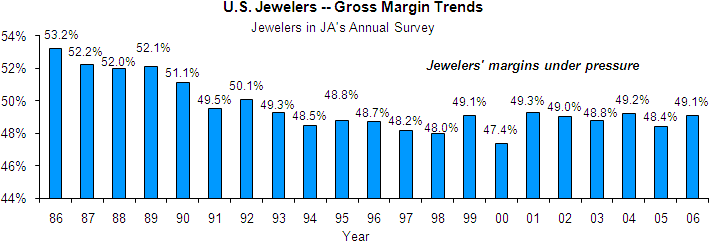
Source: Jewelers of America
Two decades ago, retail jewelers reported a comfortable “keystone” margin of about 50 percent or slightly higher; in other words, they bought an item for $1 and sold it for $2. Today, that margin has fallen into the mid-to-high 40 percent range, where it seems to be holding. For an industry that formerly earned a pretax margin of 8-9 percent, that means the decline of 4-5 percentage points in gross margin has eroded more than half of their pretax profits. Jewelers should be worried.
In an effort to recover some of this lost profitability, many retail jewelers are pounding on their suppliers for lower prices or other financial concessions. Unfortunately, this tactic will only result in putting suppliers out of business. Jewelry suppliers generally operate on much lower margins than jewelry retailers; a few points of margin squeeze for suppliers will yield a loss for them.
Chain Jewelers’ Gross Margins Mixed
While independent jewelers have generally been unable to maintain margins, some chain jewelers have been more successful. For example, Tiffany continues to increase its gross margin by internally producing a greater mix of the goods it sells. Zale’s gross margin has risen, in part because it is moving to directly sourcing goods overseas. On the other hand, Finlay’s gross margin has deteriorated, largely due to increased markdowns and a greater mix of sales from its independent specialty jewelry stores.
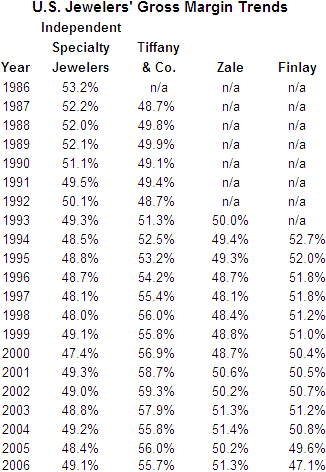
Source: Company Reports & Jewelers of America
Factors Affecting Jewelers’ Margins
There was no long laundry list of factors which affect jewelry retailers’ and suppliers’ gross margins. Here are some factors which jewelers cited that either helped boost margins (a very short list) and other factors which hurt gross margins in recent quarters (a much longer list).
The following factors have helped boost gross margins:
- Sales mix – A slight shift away from commodity products such as watches and diamonds has helped boost gross margins for a few jewelers in recent quarters. Further, there has been a shift toward designer and branded goods which, except for watches, tend to carry a higher gross margin.
- Price increases – Some retail jewelers actually have implemented price increases, and it appears that sales gains were not dampened.
The following factors have hurt gross margins for jewelers:
- Sales mix – Some jewelers continue to promote commodity products – watches, loose diamonds and diamond jewelry – which have inherently lower gross margins. Those jewelers who are selling these low-margin commodity products aren’t generating a higher inventory turn. Thus, they are locked in a downward margin spiral that will eventually sink them.
- Inflation – Jewelers report current period inflation trends via an accounting concept called a LIFO provision. LIFO stands for “Last-In, First-Out.” If a jeweler’s LIFO provision rises, it means product costs are rising in the current period. Several jewelers noted that higher gold and other precious metals costs have had a negative impact on their gross margins over the past year.
The graph below illustrates the cost increases for one year only, 2007, for four key commodities used in jewelry – diamonds, gold, silver and platinum. According to the Jewelers of America Cost of Doing Business Survey, silver and platinum each represent 2 percent or less, of a jeweler’s revenues, while gold jewelry represents about only about 10 percent of a typical specialty jeweler’s sales. World Gold Council research shows that the value of gold in all jewelry represents about 30 percent of the market. IDEX Online pegs gold jewelry sales at about 14 percent of an American jeweler’s sales. Either way, gold is a major component of jewelry.
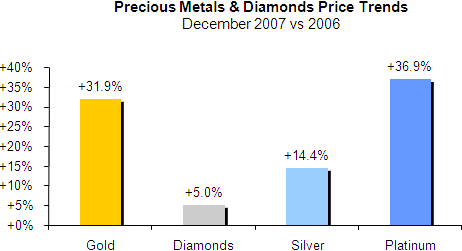 Source: IDEX Online & Kitco |
- Inventory write-downs – In an effort to move obsolete merchandise – far too often defined as merchandise which has been around for two or more years – jewelers are melting down the goods. This clearly has a negative impact on gross margins. We believe a better solution is to mark down the goods after about six months (or less); move them out, generate cash, and seek new better-selling goods.
- Currency shifts – In a multi-national business like jewelry, currency values which shift – for example, a weaker U.S. dollar – can have a negative impact on gross margins. If it takes more U.S. dollars to buy goods manufactured overseas, then gross margins typically decline.
As the graph below illustrates, the U.S. dollar has lost value against four of the five major jewelry currencies over the past year. This trend fuels significant inflation in the jewelry industry.
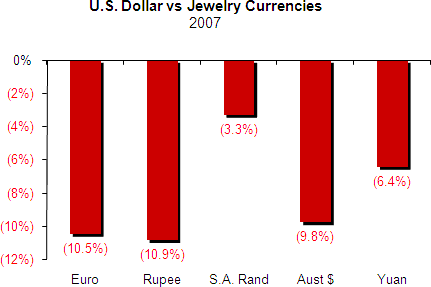 Source: Currency Market |
Raising Prices: One Way to Boost Margins
So, what can retailers do about these unfavorable gross margin trends? Signet Group chairman Terry Burman was the first to say, “Enough is enough.” Earlier this year, he announced that Sterling would begin raising its retail prices after Valentine’s 2008. He noted that it has been years since Sterling has raised prices of core product categories.
Why did Burman make this announcement? He told Wall Street analysts that they should be prepared to the possibility of some softer sales reports from Sterling Jewelers later in 2008, especially if other jewelers don’t follow Sterling’s lead and raise prices. This sounds like the airline industry, where one carrier announces prices increases, and hopes the others will follow. If no one follows Signet’s lead, the company has a choice: possibly lose market share, or roll back prices.
Does this mean the end of the opening price point of $99 for “fine” jewelry in the U.S.? That’s not likely, but it will mean that the stones will be smaller and the gold a lower karatage at this retail price level in the future. Further, it will mean that the average ticket for mass market jeweler, which has been stuck in the $300-350 range for several years, will likely move up, perhaps to near $400. However, even that level won’t allow retailers to recoup the cost increases they’ve experienced over the past several years.
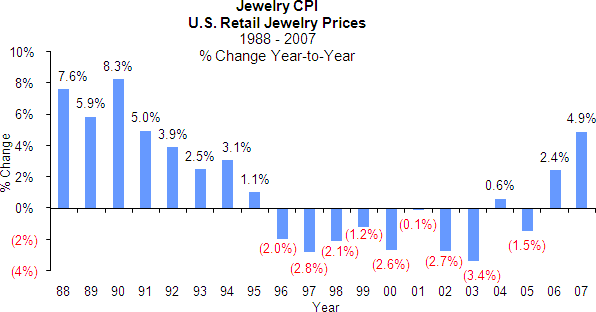
Source: BLS
Our Argument: Gross Margins Are Too High, But That Isn’t the Full Story
We have long believed that jewelers’ gross margins are too high. The spread between the cost and the retail price is too great. Increasingly well-informed shoppers are discovering this fact, too. Online jewelers are doing their best to show jewelry shoppers that there is a less expensive way to buy jewelry – one that creates value in consumers’ minds.
In a perfect world, jewelers’ gross margins would be in the 28-35 percent range, rather than at the current “keystone” 50 percent level. Most fashion retailers generate a gross margin in the 28-35 percent range; it is reasonable to believe that jewelry, a fashion item, can also be sold at prices which will yield a gross margin in this range. Online jewelers have created a highly successful financial model with gross margins in the 20-22 percent range, far lower than most store-based retailers.
But, here’s the catch: if gross margins decline, inventory turn must rise significantly to near three turns annually from the current level of only about one turn annually. Most fashion retailers turn their inventory 3-4 times annually. Unfortunately, it is necessary for jewelers to generate a high gross margin because their inventory turns are so low. Financial productivity measures such as turnover of capital and the return on capital are calculated as a function of inventory turn and gross margin. If one is too low (in the case of jewelers, it is inventory turn), then the other must be very high to compensate (in the case of jewelers, it is the gross margin which is high). This concept is called GMROI – Gross Margin Return On Investment – which simplistically calculates the return on capital by measuring inventory turn and gross profit.
Here’s an exaggerated example designed to help jewelers understand the concept of inventory turn versus gross margin (and gross profit dollars). We often ask retail jewelers this question: Should you continue to operate with your current financial model – an inventory turn of once annually with a 50 percent gross margin – or with a new model – 365 times inventory turn with a one percent gross margin? Far too many jewelers answer that the current model would be better. But they are wrong: if they buy something for $100, and sell it for $200 (gross margin of 50 percent) once a year, their gross profit for the year is $100. If they buy something for $100 and sell it for $101 (gross margin of one percent) every day of the year (a 365 times inventory turn), they will end the year with $365 of gross profit. Far too many jewelers don’t understand this concept.
Unfortunately, the industry is not about to embrace a new financial model rapidly. We note, however, that online jewelers will likely force retail jewelers to create a new financial model that will result in lower gross margins but higher inventory turns, though not at the level of online jewelers. Online jewelers have financial advantages that store-based jewelers simply don’t have.
Outlook for 2008
Despite the recessionary environment in the U.S. market, costs continue to rise due to the factors listed above. As long as costs are rising, gross margins will be under unrelenting pressure.